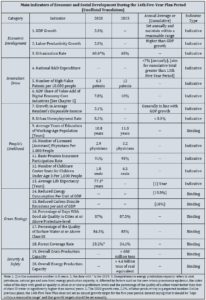On March 13, 2021, China’s National People’s Congress (NPC) approved the outline of the country’s 14th Five-Year Plan, covering the period 2021-2025. The plan’s economic and social development targets provide critical signposts that companies—both foreign and domestic—would be wise to heed when determining their own plans for the coming months and years in the Chinese market. The full text of the plan can be accessed here in its original Chinese. This article will be updated with a link to an English translation once it becomes available.
The five-year plan is the centerpiece of the Chinese system of industrial planning and policy. Reflecting the transformation of the country over the past 70 years, the content and purpose of the five-year plan has changed substantially since the first plan was issued in Mao Zedong’s China in 1953. As the economy has evolved from a pure command economy to one in which the market plays a greater role, albeit with substantial engagement and interventions by the government, the five-year plan has evolved as well. Early plans set production targets; modern plans are a mixture of principles, guidelines, and targets designed to steer the country’s development. This evolution has not reduced the importance of the five-year plan—it remains a central feature of the Chinese economic system—but it does affect how it should be interpreted and how its guidance is implemented in practice. Ultimately, the five-year plan’s purpose is to set strategic goals, focus government work, and guide the activities of market and non-market entities in China. In developing the 14th Five-Year Plan, China’s leaders set an ambitious agenda to “promote high-quality development in all aspects, including the economy, environment, and people’s livelihood and wellbeing, and realize the rise of China’s economy in the global industrial chain and value chain.”
The 14th Five-Year Plan consists of 19 chapters and 65 sub-chapters; sets out 20 main indicators for economic and social development (see chart below); and describes several measures and initiatives, including 102 major engineering projects slated for the coming five-year period. Local and sectoral plans fleshing out these targets in greater detail will be released throughout the year.

A Vision for a Technologically Advanced and Self-Reliant China
Technology lies at the heart of China’s vision for its future, and accordingly, the 14th Five-Year Plan dedicates the first topical chapter (Chapter 2) to the topic of innovation. This chapter is divided into four sections that, respectively, describe areas where the government should play a leading role, support the companies, develop human capital, and “perfect” the ecosystem for innovation (including the promotion of collaboration and improved intellectual property protection).
Themes of self-reliance and technological independence, which are woven throughout the plan, figure prominently in this chapter. Among other things, the plan names seven “frontier” technology fields in which the state should cultivate domestic capabilities via major national science and technology projects:
- New Generation Artificial Intelligence;
- Quantum Information;
- Integrated Circuits (or Semiconductors);
- Neuroscience and Brain-Inspired Research;
- Genetics and Biotechnology;
- Clinical Medicine & Health;
- Deep Sea, Deep Space, and Polar Exploration.
Several other chapters also expand on China’s technological ambitions:
- Chapter 3, on the topic of developing an advanced industrial system, delves into China’s plans to strengthen its role as a manufacturing superpower—including eight areas of focus, among them new energy and autonomous vehicles, high-end medical devices, and innovative medicines—and China’s goals for infrastructure modernization.
- Chapter 4, which discusses developing China’s domestic market and building a “new development pattern,” centers around the “dual circulation strategy” first articulated by President Xi Jinping in May 2020 as China began to plan its post-pandemic economic recovery. The dual circulation strategy aims to promote a stronger domestic market (“internal circulation”) while continuing to strengthen China’s international economic position (“external circulation”). To some degree, this policy is new packaging for the longstanding goal of reducing reliance on export-led development and relying more heavily on the domestic cycle of innovation, manufacturing, and consumption to drive development; but it also reflects growing mandates to promote economic self-reliance, especially in technology-related fields.
- Chapter 5 describes plans for building a “digital China,” with seven core industries at the fore—cloud computing, big data, internet of things, industrial internet, blockchain, artificial intelligence, and virtual and augmented reality—and ten areas where such technologies should be applied, including smart transportation, smart energy, smart manufacturing, smart medicine, and smart government.
*
The themes and targets in this plan will guide decision making at all levels of government. Provincial, municipal, and sectoral plans will be released throughout the year that will describe these targets in greater detail, as well as some of the policies and mechanisms that will be used to achieve them. Companies, organizations, and governments with interests in China should carefully review the 14th Five-Year Plan to understand the high-level policy direction and goals of the Chinese government, and then monitor corresponding activities as China’s industrial policy apparatus at the central and local levels begins to take concrete steps towards implementation.
Silvia Huang of Covington & Burling LLP assisted with the research for this article.